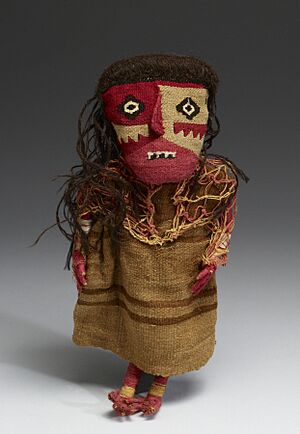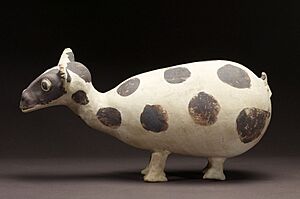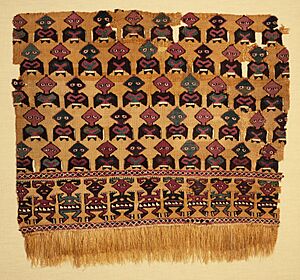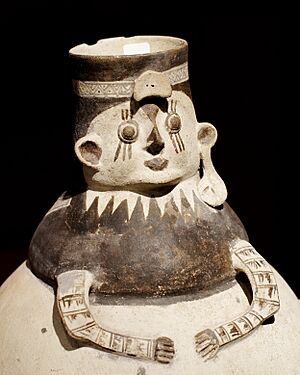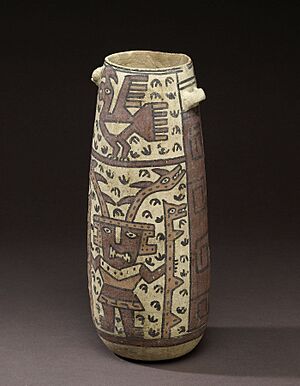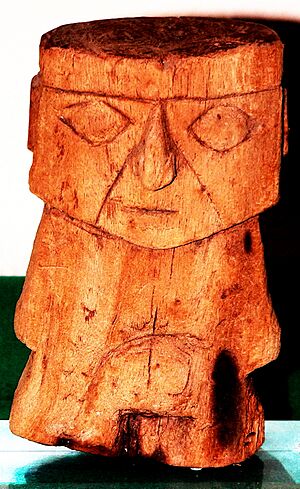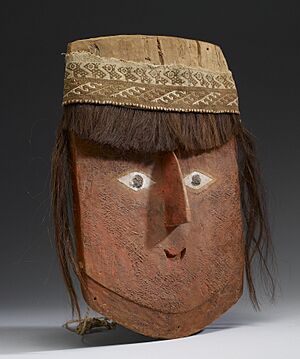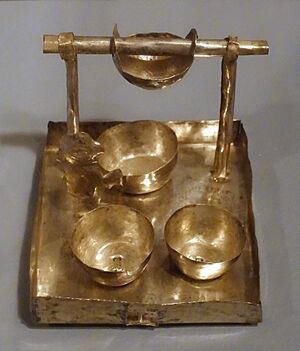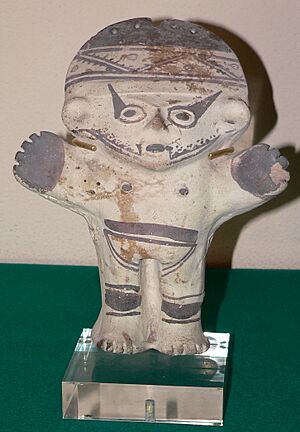Chancay culture facts for kids
The Chancay were an ancient civilization that lived on the central coast of Peru a long time ago, from about the year 1000 to 1470 CE. They lived in the valleys of Fortaleza, Pativilca, Supe, Huaura, Chancay, Chillón, Rimac, and Lurín.
Contents
Chancay History and Location
We don't know a lot about the Chancay civilization. They appeared after another big civilization, the Wari, declined. The Chancay culture grew stronger just before the famous Inca Empire became very powerful.
Around the early 1400s, parts of the Chancay lands were taken over by the Chimú people. By about 1450 CE, the Incas started to control both the Chimú and Chancay areas. This led to the Chancay culture becoming less powerful as the Inca Empire grew.
The Chancay people lived along the central coast of Peru. Their main area was in the Chancay and Chillón valleys. The center of their culture was about 80 kilometers (50 miles) north of Lima. Even though it was a desert region, the valleys had fertile land and rivers. This allowed them to grow many crops.
The Chancay also traded a lot with other regions. This helped them connect with different cultures and communities far and wide.
How the Chancay Made a Living
The Chancay people got their food and resources mainly from farming, fishing, and trading. They built special water reservoirs and irrigation canals to help their farms grow.
Since they lived by the ocean, fishing was very important. They fished from the shore and also used unique ancient boats called caballitos de totora to go further out to sea.
The Chancay also traded goods with people from the Peruvian highlands and jungle by land. They even traded by sea with groups to the north and south of their territory.
Some of their towns, like Lauri and Pisquillo Chico, were known for their skilled artisans. These artisans made many ceramics, textiles, and metal objects. The Chancay culture was one of the first in Peru to produce these items in large amounts. They also made beautiful things from carved wood.
Their leaders, called curacas, helped organize the work of farmers, artisans, and herders. They also oversaw important celebrations.
Amazing Chancay Textiles
The Chancay are most famous for their incredible textiles. These include embroidered pieces and different kinds of painted fabrics. They used many techniques, colors, and designs. Their textiles often featured colors like yellow, brown, red, white, blue, and green.
They used materials like llama wool, cotton, and even feathers. They created open-weave fabrics, brocade, embroidery, and painted designs. Artists used brushes to paint human-like figures, animal shapes, geometric patterns, and other creative designs directly onto the cloth. The Chancay were especially good at making painted tapestries.
Their designs often included geometric shapes, plants, and animals. You can see fish, cats, birds, monkeys, and even the hairless Peruvian dog in their art. They also showed human figures. Some detailed fabric sculptures show scenes like a mother teaching her daughter to weave on a backstrap loom. Birds and gods wearing crescent-shaped headdresses were also common designs. They made clothes, bags, and even masks for burials.
Many Chancay textiles still exist today. This suggests they made a huge number of them. The textiles were made with great care and are of good quality.
Special thin fabrics, like gauzes, were used for religious and magical purposes. They were often used as headdresses for the dead. People believed that the threads in these fabrics had to be spun in a special way, called lloque. This magical thread was thought to give the clothes supernatural powers and protect people in the afterlife. Feathers were often attached to a main thread and then sewn onto the fabric.
The Chancay also made dolls and other objects covered with woven fabric pieces and different threads.
Chancay Pottery and Ceramics
Ceramics are another common type of artifact from the Chancay culture. Much of this pottery has been found in cemeteries in the Ancon and Chancay valleys. The Chancay civilization made a lot of pottery using molds. However, they also created unique open vessels with over 400 different drawings that we still don't fully understand.
Their pottery usually has a rough, matte surface. They often painted dark colors, like black or brown, on top of a lighter cream or white background. This style is known as "black on white."
Chancay vessels are often large and have interesting shapes. Egg-shaped jars are quite common. They also made ceramic dolls or female figures. These were usually large, clay dolls that looked like women. Their faces and sometimes the upper body were decorated with geometric shapes. Some ceramic figures show imprints of textiles, meaning they were dressed in real clothes. This made them look more lifelike. The eyes on these figures were often highlighted with a line on each side, and their arms were usually short.
Other common ceramic items include tall jars with narrow necks and wide mouths. These often have human faces and geometric designs painted in the black-on-cream style. They also made animal-shaped vessels, like birds or llamas.
Another special type of figure is the cuchimilco. These are small, standing human-shaped idols with strong jaws and wide, black-painted eyes. These figures are unique because their arms are raised upwards with their palms facing out, often blackened. Cuchimilcos have been found in the tombs of important Chancay people.
Chancay Wood Carvings
The Chancay people were skilled wood carvers. Their wood carvings are simple and often show shapes from nature. This is different from their very detailed textile art. They made everyday tools, statues, and decorative items from wood, sometimes painting them.
Using wood from their coastal desert, the Chancay carved both large and small objects. They often engraved them with designs inspired by the ocean, like seabirds and boats.
They also made tools for weaving, farming, and fishing. Many wooden objects were used for religious ceremonies or to show a person's social status.
Carved human heads made of wood were common. These were placed on top of mummies of important leaders. This showed their high status, like a god or an important ancestor, after they died. Wooden human figures could also represent political power, especially when carved into staffs or command batons.
Chancay Buildings and Society
The Chancay civilization built large urban centers. These cities had pyramid-shaped mounds and complex buildings. Their society was organized into different types of communities, called ayllus, which were controlled by leaders known as curacas.
The urban centers had special buildings for religious ceremonies and government activities. They also included homes for important people. These cities were quite large, possibly because they produced so many goods.
Chancay society had different social classes, meaning some people had more power or wealth than others. This social structure was also present in their smaller towns.
Most of their buildings were made from adobe bricks. They were built in groups and followed a similar design. Sometimes, the most important buildings combined adobe with stones. People lived in areas based on their trade, which helped them produce goods in large quantities.
Access to the pyramids was through ramps, meaning you would walk up or down them. The Chancay also built impressive water systems, like reservoirs and irrigation canals, to manage water for their farms.
|
See also
In Spanish: Cultura chancay para niños


